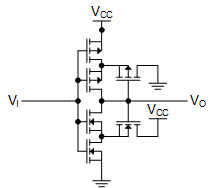Other Parts Discussed in Thread: SN74LVC2G14, SN74AUP2G14
Given that the positive and negative switching thresholds have a pretty high tolerance, how safe is the assumption that they are symmetric around the actual swithing threshold of the internal logic?
It is unknown how the hysteresis is implemented, but I'd guess that it is some resistive feedback network.
In that case I'd expect symmetry, but there are reports about anomalous negative thresholds at least above 3V.
Background: I want to so a simple RC-Oscillator, but the duty cycle should be near 50%. I.e. the thresholds ought to be roughly symmetric around Vcc/2.
Same question applies to SN74LVC2g14 (of course) and also to SN74AUP2G14.



